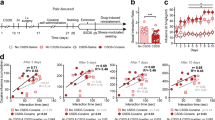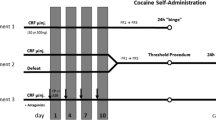Abstract
Rationale
Escalated, binge-like patterns of cocaine self-administration are engendered by repeated, intermittent exposure to episodes of social defeat stress, as well as by extended drug access.
Objectives
The present study investigated if prior exposure to brief episodes of social defeat stress would intensify the escalation of cocaine self-administration associated with extended access conditions. The consequences of both stress sensitization and prolonged access were further assessed with progressive ratio (PR) break points and during a 24-h variable dose “binge”.
Methods
Male Long–Evans rats were exposed to four episodes of defeat stress (days 1–4–7–10), and their locomotor response to cocaine was assessed 10 days later. Rats were subsequently implanted with intravenous catheters. After acquisition, stressed and control rats were allowed daily short (1 h/day) or extended (6 h/day) sessions of cocaine self-administration for 14 days (0.75 mg/kg/infusion). In sequence, we determined break points for cocaine on PR tests and assessed drug intake patterns during a 24-h variable dose binge.
Results
Defeat stress induced cross-sensitization to a cocaine challenge, increased break points for cocaine, and produced persistent, escalated cocaine taking during a 24-h binge. Rats with extended access to cocaine—both stressed and controls—similarly escalated their drug intake throughout the 14 days. Extended access conditions accelerated the rate of cocaine self-administration in the first half of the binge, indicated by shorter post-infusion intervals, but failed to amplify the accumulated drug intake in non-stressed controls.
Conclusions
Both social defeat stress and drug access conditions may engender escalated cocaine intake via distinct mechanisms that regulate drug self-administration.





Similar content being viewed by others
Reference
Ahmed SH, Cador M (2006) Dissociation of psychomotor sensitization from compulsive cocaine consumption. Neuropsychopharmacology 31:563–571
Ahmed SH, Koob GF (1998) Transition from moderate to excessive drug intake: change in hedonic set point. Science 282:298–300
Ahmed SH, Koob GF (1999) Long-lasting increase in the set point for cocaine self-administration after escalation in rats. Psychopharmacology 146:303–312
Ahmed SH, Walker JR, Koob GF (2000) Persistent increase in the motivation to take heroin in rats with a history of drug escalation. Neuropsychopharmacology 22:413–421
Ahmed SH, Kenny PJ, Koob GF, Markou A (2002) Neurobiological evidence for hedonic allostasis associated with escalating cocaine use. Nat Neurosci 5:625–626
Cabib S, Orsini C, Le Moal M, Piazza PV (2000) Abolition and reversal of strain differences in behavioral responses to drugs of abuse after a brief experience. Science 289:463–465
Covington HE III, Miczek KA (2001) Repeated social-defeat stress, cocaine or morphine. Effects on behavioral sensitization and intravenous cocaine self-administration “binges”. Psychopharmacology (Berl) 158:388–398
Covington HE III, Miczek KA (2005) Intense cocaine self-administration after episodic social defeat stress, but not after aggressive behavior: dissociation from corticosterone activation. Psychopharmacology (Berl) 183:331–340
Covington HE III, Tropea TF, Rajadhyaksha AM, Kosofsky BE, Miczek KA (2008) NMDA receptors in the rat VTA: a critical site for social stress to intensify cocaine taking. Psychopharmacology (Berl) 197:203–216
Deroche V, Marinelli M, Maccari S, Lemoal M, Simon H, Piazza PV (1995) Stress-induced sensitization and glucocorticoids. 1. Sensitization of dopamine-dependent locomotor effects of amphetamine and morphine depends on stress-induced corticosterone secretion. J Neurosci 15:7181–7188
Ferrario CR, Robinson TE (2007) Amphetamine pretreatment accelerates the subsequent escalation of cocaine self-administration behavior. Eur Neuropsychopharmacol 17:352–357
Ferrario CR, Gorny G, Crombag HS, Li Y, Kolb B, Robinson TE (2005) Neural and behavioral plasticity associated with the transition from controlled to escalated cocaine use. Biol Psychiatry 58:751–759
Fish EW, Faccidomo S, Miczek KA (1999) Aggression heightened by alcohol or social instigation in mice: reduction by the 5-HT1B receptor agonist CP-94, 253. Psychopharmacology 146:391–399
Gawin FH (1991) Cocaine addiction: psychology and neurophysiology. Science 251(5001):1580–6
Gawin FH, Kleber HD (1988) Evolving conceptualizations of cocaine dependence. Yale J Biol Med 61(2):123–136
Gerber GJ, Wise RA (1989) Pharmacological regulation of intravenous cocaine and heroin self-administration in rats: a variable dose paradigm. Pharmacol Biochem Behav 32:527–531
Goeders NE (2002) The HPA axis and cocaine reinforcement. Psychoneuroendocrinology 27:13–33
Goeders NE (2003) The impact of stress on addiction. Eur Neuropsychopharmacol 13(6):435–41
Grimm JW, Hope BT, Wise RA, Shaham Y (2001) Neuroadaptation. Incubation of cocaine craving after withdrawal. Nature 412(6843):141–142
Hodos W (1961) Progressive ratio as a measure of reward strength. Science 134:943–944
Kabbaj M, Norton CS, Kollack-Walker S, Watson SJ, Robinson TE, Akil H (2001) Social defeat alters the acquisition of cocaine self-administration in rats: role of individual differences in cocaine-taking behavior. Psychopharmacology (Berl) 158:382–387
Knackstedt LA, Kalivas PW (2007) Extended access to cocaine self-administration enhances drug-primed reinstatement but not behavioral sensitization. J Pharmacol Exp Ther 322:1103–1109
Koob G, Kreek MJ (2007) Stress, dysregulation of drug reward pathways, and the transition to drug dependence. Am J Psychiatry 164:1149–1159
Koob GF, Le Moal M (1997) Drug abuse: hedonic homeostatic dysregulation. Science 278:52–59
Lenoir M, Ahmed SH (2007) Heroin-induced reinstatement is specific to compulsive heroin use and dissociable from heroin reward and sensitization. Neuropsychopharmacology 32:616–624
Liu Y, Roberts DC, Morgan D (2005) Effects of extended-access self-administration and deprivation on breakpoints maintained by cocaine in rats. Psychopharmacology (Berl) 179:644–651
Lu L, Grimm JW, Hope BT, Shaham Y (2004) Incubation of cocaine craving after withdrawal: a review of preclinical data. Neuropharmacology 47(S1):214–226
Mantsch JR, Katz ES (2007) Elevation of glucocorticoids is necessary but not sufficient for the escalation of cocaine self-administration by chronic electric footshock stress in rats. Neuropsychopharmacology 32:367–376
Mantsch JR, Yuferov V, Mathieu-Kia AM, Ho A, Kreek MJ (2004) Effects of extended access to high versus low cocaine doses on self-administration, cocaine-induced reinstatement and brain mRNA levels in rats. Psychopharmacology (Berl) 175:26–36
Mantsch JR, Baker DA, Serge JP, Hoks MA, Francis DM, Katz ES (2008) Surgical adrenalectomy with diurnal corticosterone replacement slows escalation and prevents the augmentation of cocaine-induced reinstatement in rats self-administering cocaine under long-access conditions. Neuropsychopharmacology 33:814–826
Marinelli M, Piazza PV (2002) Interaction between glucocorticoid hormones, stress and psychostimulant drugs. Eur J NeuroSci 16:387–394
Miczek KA, Mutschler NH (1996) Activational effects of social stress on IV cocaine self-administration in rats. Psychopharmacology 128:256–264
Miczek KA, Covington HE, Nikulina EA, Hammer RP (2004) Aggression and defeat: persistent effects on cocaine self-administration and gene expression in peptidergic and aminergic mesocorticolimbic circuits. Neurosci Biobehav Rev 27:787–802
Miczek KA, Yap JJ, Covington HE III (2008) Social stress, therapeutics and drug abuse: preclinical models of escalated and depressed intake. Pharmacol Ther 120:102–128
Moffett MC, Vicentic A, Kozel M, Plotsky P, Francis DD, Kuhar MJ (2007) Maternal separation alters drug intake patterns in adulthood in rats. Biochem Pharmacol 73:321–330
Morgan D, Roberts DCS (2004) Sensitization to the reinforcing effects of cocaine following binge-abstinent self-administration. Neurosci Biobehav Rev 27:803–812
National Research Council (1996) Guide for the care and use of laboratory animals. National Academy Press, Washington DC
Nikulina EM, Covington HE III, Ganschow L, Hammer RP Jr, Miczek KA (2004) Long-term behavioral and neuronal cross-sensitization to amphetamine induced by repeated brief social defeat stress: Fos in the ventral tegmental area and amygdala. Neuroscience 123:857–865
Oleson EB, Roberts DC (2009) Behavioral economic assessment of price and cocaine consumption following self-administration histories that produce escalation of either final ratios or intake. Neuropsychopharmacology 34(3):796–804
Oleson EB, Talluri S, Childers SR, Smith JE, Roberts DC, Bonin KD, Budygin EA (2009) Dopamine uptake changes associated with cocaine self-administration. Neuropsychopharmacology 34(5):1174–84
Pacchioni AM, Gioino G, Assis A, Cancela LM (2002) A single exposure to restraint stress induces behavioral and neurochemical sensitization to stimulating effects of amphetamine: involvement of NMDA receptors. Ann N Y Acad Sci 965:233–246
Paterson NE, Markou A (2003) Increased motivation for self-administered cocaine after escalated cocaine intake. NeuroReport 14:2229–2232
Richardson NR, Roberts DCS (1996) Progressive ratio schedules in drug self-administration studies in rats: a method to evaluate reinforcing efficacy. J Neurosci Methods 66:1–11
Roberts DC, Morgan D, Liu Y (2007) How to make a rat addicted to cocaine. Prog Neuropsychopharmacol Biol Psychiatry 31:1614–1624
Robinson TE, Berridge KC (1993) The neural basis of drug craving: an incentive-sensitization theory of addiction. Brain Res Brain Res Rev 18:247–291
Robinson TE, Berridge KC (2000) The psychology and neurobiology of addiction: an incentive-sensitization view. Addiction 95:S91–S117
Roth ME, Carroll ME (2004) Sex differences in the escalation of intravenous cocaine intake following long- or short-access to cocaine self-administration. Pharmacol Biochem Behav 78:199–207
Rouge-Pont F, Marinelli M, Le Moal M, Simon H, Piazza PV (1995) Stress-induced sensitization and glucocorticoids. 2. Sensitization of the increase in extracellular dopamine induced by cocaine depends on stress-induced corticosterone secretion. J Neurosci 15:7189–7195
Sinha R (2001) How does stress increase risk of drug abuse and relapse? Psychopharmacology (Berl) 158(4):343–359
Sinha R (2008) Chronic stress, drug use, and vulnerability to addiction. Ann N Y Acad Sci 1141:105–130
Sorge RE, Stewart J (2005) The contribution of drug history and time since termination of drug taking to footshock stress-induced cocaine seeking in rats. Psychopharmacology (Berl) 183(2):210–217
Tidey JW, Miczek KA (1997) Acquisition of cocaine self-administration after social stress: role of accumbens dopamine. Psychopharmacology (Berl) 130:203–212
Tornatzky W, Miczek KA (1993) Long-term impairment of autonomic circadian rhythms after brief intermittent social stress. Physiol Behav 53:983–993
Tornatzky W, Miczek KA (2000) Cocaine self-administration “binges”: transition from behavioral and autonomic regulation toward homeostatic dysregulation in rats. Psychopharmacology 148:289–298
Vezina P (2004) Sensitization of midbrain dopamine neuron reactivity and the self-administration of psychomotor stimulant drugs. Neurosci Biobehav Rev 27:827–839
Wee S, Mandyam CD, Lekic DM, Koob GF (2008) Alpha 1-noradrenergic system role in increased motivation for cocaine intake in rats with prolonged access. Eur Neuropsychopharmacol 18:303–311
Acknowledgments
This research was supported by NIDA research grant DA02632 (KAM, PI). We thank Mr. J. Thomas Sopko for outstanding technical assistance, and Jonaton Jang and Fabio C Cruz who assisted with experimental procedures.
Author information
Authors and Affiliations
Corresponding author
Rights and permissions
About this article
Cite this article
Quadros, I.M.H., Miczek, K.A. Two modes of intense cocaine bingeing: increased persistence after social defeat stress and increased rate of intake due to extended access conditions in rats. Psychopharmacology 206, 109–120 (2009). https://doi.org/10.1007/s00213-009-1584-6
Received:
Accepted:
Published:
Issue Date:
DOI: https://doi.org/10.1007/s00213-009-1584-6




